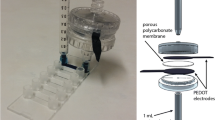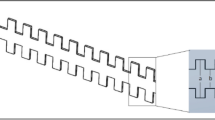Abstract
Hydrostatic pressure can affect the structure and function of endothelial cells (ECs). A microfluidic system was built to study how ECs respond to applied pressure. The system included a syringe pump, a PDMS-glass microfluidic chip, and a digital manometer for pressure monitoring. The manometer was connected with the chip in two ways (one was before the inlet and the other after the outlet of the microchannel). The static control and flowing control systems were also set up. Human umbilical vein endothelial cells (HUVECs) were cultured in the 4 cm × 2 mm × 100 μm channel. Pressure of 12 ± 0.5 or 18 ± 0.5 kPa was applied on the cells for 8 h. The F-actin cytoskeleton and the nuclei of the cells were stained for examination and endothelin-1 (ET-1) released from the cells in the channel was assayed by ELISA. The results showed that the cell area and ET-1 concentration increased with the pressure and a higher pressure caused more damages to the cells. This microfluidic system provides a convenient and cost-effective platform for the studies of cell response to pressure.







Similar content being viewed by others
References
Barkefors I, Thorslund S, Nikolajeff F, Kreuger J (2009) A fluidic device to study directional angiogenesis in complex tissue and organ culture models. Lab Chip 9(4):529–535. doi:10.1039/b814691h
Cooke BM, Usami S, Perry I, Nash GB (1993) A simplified method for culture of endothelial cells and analysis of adhesion of blood cells under conditions of flow. Microvasc Res 45(1):33–45. doi:10.1006/mvre.1993.1004
Cutler JA, Sorlie PD, Wolz M, Thom T, Fields LE, Roccella EJ (2008) Trends in hypertension prevalence, awareness, treatment, and control rates in United States adults between 1988–1994 and 1999–2004. Hypertension 52(5):818–827. doi:10.1161/HYPERTENSIONAHA.108.113357
Davies PF, Barbee KA, Volin MV, Robotewskyj A, Chen J, Joseph L, Griem ML, Wernick MN, Jacobs E, Polacek DC, dePaola N, Barakat AI (1997) Spatial relationships in early signaling events of flow-mediated endothelial mechanotransduction. Annu Rev Physiol 59:527–549. doi:10.1146/annurev.physiol.59.1.527
Diamond SL, Eskin SG, McIntire LV (1989) Fluid flow stimulates tissue plasminogen activator secretion by cultured human endothelial cells. Science 243(4897):1483–1485
Duffy DC, McDonald JC, Schueller OJA, Whitesides GM (1998) Rapid prototy** of microfluidic systems in poly(dimethylsiloxane). Anal Chem 70(23):4974–4984
El-Ali J, Sorger PK, Jensen KF (2006) Cells on chips. Nature 442(7101):403–411. doi:10.1038/nature05063
Eskin SG, Ives CL, McIntire LV, Navarro LT (1984) Response of cultured endothelial cells to steady flow. Microvasc Res 28(1):87–94
Estrada R, Giridharan GA, Nguyen MD, Roussel TJ, Shakeri M, Parichehreh V, Prabhu SD, Sethu P (2011) Endothelial cell culture model for replication of physiological profiles of pressure, flow, stretch, and shear stress in vitro. Anal Chem 83(8):3170–3177. doi:10.1021/ac2002998
Gallik S, Usami S, Jan KM, Chien S (1989) Shear stress-induced detachment of human polymorphonuclear leukocytes from endothelial cell monolayers. Biorheology 26(4):823–834
Gray BL, Lieu DK, Collins SD, Smith RL, Barakat AI (2002) Microchannel platform for the study of endothelial cell shape and function. Biomed Microdevices 4(1):9–16
Hishikawa K, Nakaki T, Marumo T, Suzuki H, Kato R, Saruta T (1995) Pressure enhances endothelin-1 release from cultured human endothelial cells. Hypertension 25(3):449–452
Iglarz M, Schiffrin EL (2003) Role of endothelin-1 in hypertension. Curr Hypertens Rep 5(2):144–148
Levesque MJ, Nerem RM, Sprague EA (1990) Vascular endothelial cell proliferation in culture and the influence of flow. Biomaterials 11(9):702–707
Muller-Marschhausen K, Waschke J, Drenckhahn D (2008) Physiological hydrostatic pressure protects endothelial monolayer integrity. Am J Physiol Cell Physiol 294(1):C324–C332. doi:10.1152/ajpcell.00319.2007
Ono O, Ando J, Kamiya A, Kuboki Y, Yasuda H (1991) Flow effects on cultured vascular endothelial and smooth muscle cell functions. Cell Struct Funct 16(5):365–374
Sainani GS, Maru VG (2004) Role of endothelial cell dysfunction in essential hypertension. J Assoc Physicians India 52:966–969
Schiffrin EL (2001) Role of endothelin-1 in hypertension and vascular disease. Am J Hypertens 14(6 Pt 2):83S–89S
Schwartz EA, Bizios R, Medow MS, Gerritsen ME (1999) Exposure of human vascular endothelial cells to sustained hydrostatic pressure stimulates proliferation. Involvement of the alphaV integrins. Circ Res 84(3):315–322
Shamloo A, Ma N, Poo MM, Sohn LL, Heilshorn SC (2008) Endothelial cell polarization and chemotaxis in a microfluidic device. Lab Chip 8(8):1292–1299. doi:10.1039/b719788h
Shichiri M, Hirata Y, Ando K, Emori T, Ohta K, Kimoto S, Ogura M, Inoue A, Marumo F (1990) Plasma endothelin levels in hypertension and chronic renal failure. Hypertension 15(5):493–496
Song JW, Gu W, Futai N, Warner KA, Nor JE, Takayama S (2005) Computer-controlled microcirculatory support system for endothelial cell culture and shearing. Anal Chem 77(13):3993–3999. doi:10.1021/ac050131o
Sumpio BE, Widmann MD, Ricotta J, Awolesi MA, Watase M (1994) Increased ambient pressure stimulates proliferation and morphologic changes in cultured endothelial cells. J Cell Physiol 158(1):133–139. doi:10.1002/jcp.1041580117
Thorin-Trescases N, Bartolotta T, Hyman N, Penar PL, Walters CL, Bevan RD, Bevan JA (1997) Diameter dependence of myogenic tone of human pial arteries possible relation to distensibility. Stroke 28(12):2486–2492
Tkachenko E, Gutierrez E, Ginsberg MH, Groisman A (2009) An easy to assemble microfluidic perfusion device with a magnetic clamp. Lab Chip 9(8):1085–1095. doi:10.1039/b812184b
Tokunaga O, Watanabe T (1987) Properties of endothelial cell and smooth muscle cell cultured in ambient pressure. In Vitro Cell Dev Biol 23(8):528–534
van der Meer AD, Poot AA, Duits MH, Feijen J, Vermes I (2009) Microfluidic technology in vascular research. J Biomed Biotechnol 2009:823148. doi:10.1155/2009/823148
Yanagisawa M, Kurihara H, Kimura S, Tomobe Y, Kobayashi M, Mitsui Y, Yazaki Y, Goto K, Masaki T (1988) A novel potent vasoconstrictor peptide produced by vascular endothelial cells. Nature 332(6163):411–415. doi:10.1038/332411a0
Acknowledgments
The work was supported by National Basic Research Program of China (No. 2011CB933102), National Natural Science Foundation of China (No. 61078074 and 11004205) and Hong Kong RGC (No. GRF604712). The authors thank Dr. **g Li from the School of Public Health, Peking University, for his kind permission to use the microplate reader. The authors also express gratitude to Dr. Zhizhu He for helpful discussions.
Author information
Authors and Affiliations
Corresponding authors
Rights and permissions
About this article
Cite this article
Li, L., Yang, Y., Shi, X. et al. A microfluidic system for the study of the response of endothelial cells under pressure. Microfluid Nanofluid 16, 1089–1096 (2014). https://doi.org/10.1007/s10404-013-1275-9
Received:
Accepted:
Published:
Issue Date:
DOI: https://doi.org/10.1007/s10404-013-1275-9




